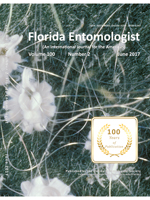The pteromalid pupal parasitoids Muscidifurax raptor Girault & Sanders and Spalangia cameroni Perkins (Hymenoptera: Pteromalidae) are commonly released on livestock farms for management of house flies, Musca domestica L. (Diptera: Muscidae). To be effective, parasitoids must be able to locate live host puparia in complex environments that may include dead or formerly parasitized hosts and non-host physical objects. In this study, both species of parasitoids were examined for their ability to kill and parasitize live house fly puparia either alone or in mixtures with formerly parasitized (dead) hosts or similarly sized acrylic beads. Muscidifurax raptor killed significantly fewer hosts and produced fewer progeny when the parasitoids were provided with hosts that were mixed with formerly parasitized puparia. Spalangia cameroni was unaffected by the presence of formerly parasitized puparia for any of the measured variables. When beads were used as a decoy instead of formerly parasitized puparia, high bead-to-live-host ratios (90% decoys) resulted in significantly fewer numbers of hosts killed by M. raptor compared with the other treatments (50% and no decoys). Residual host mortality at the high bead-to-live-host ratio (90% decoys) was lower (31.2%) than in ratios of 50:50 and with no decoys (51.6 and 59.3%, respectively), so that progeny production by M. raptor was unaffected by the presence of beads. Spalangia cameroni killed over twice as many hosts and produced twice as many progeny in the absence of bead decoys than when beads made up 90% of the decoy—host mixture. The results support the scatter method for deploying parasitized puparia during releases, because the presence of formerly parasitized hosts did not interfere substantially with the ability of S. cameroni and M. raptor to locate and parasitize live pupae.
How to translate text using browser tools
1 June 2017
Effect of Host Decoys on the Ability of the Parasitoids Muscidifurax raptor and Spalangia cameroni (Hymenoptera: Pteromalidae) to Parasitize House Fly (Diptera: Muscidae) Puparia
Dana M. Johnson,
Emily K. Rizzo,
Caitlin Taylor,
Christopher J. Geden

Florida Entomologist
Vol. 100 • No. 2
June 2017
Vol. 100 • No. 2
June 2017
biocontrol
busqueda de hospederos
Control biológico
host-finding
mosca del estable
Musca domestica
Musca donestica




